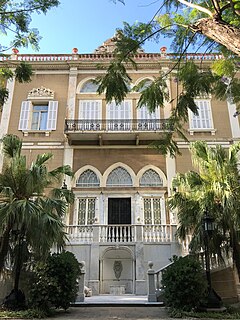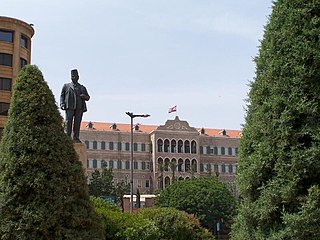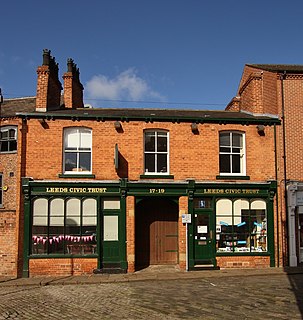
A listed building, or listed structure, is one that has been placed on one of the four statutory lists maintained by Historic England in England, Historic Environment Scotland in Scotland, Cadw in Wales and the Northern Ireland Environment Agency in Northern Ireland.

The New York City Landmarks Preservation Commission (LPC) is the New York City agency charged with administering the city's Landmarks Preservation Law. The LPC is responsible for protecting New York City's architecturally, historically, and culturally significant buildings and sites by granting them landmark or historic district status, and regulating them after designation. It is the largest municipal preservation agency in the nation. As of July 1, 2020, the LPC has designated more than 37,000 landmark properties in all five boroughs. Most of these are concentrated in historic districts, although there are over a thousand individual landmarks, as well as numerous interior and scenic landmarks.

Achrafieh is an area in eastern Beirut, Lebanon. In strictly administrative terms, the name refers to a sector (secteur) centred on Sassine Square, the highest point in the city, as well as a broader quarter (quartier). In popular parlance, however, Achrafieh refers to the whole hill that rises above Gemmayze in the north and extends to Badaro in the south, and includes the Rmeil quarter.

The Grand Serail is the headquarters of the Prime Minister of Lebanon. It is situated atop a hill in downtown Beirut a few blocks away from the Lebanese Parliament building. The Grand Serail is a historic building, the most important of three Ottoman monuments on the Serail hill. The other two are the Council for Development and Reconstruction and the Hamidiyyeh clock tower. This historic building has earned its importance through successive roles which it held since 1832

The Beirut Central District (BCD) or Centre Ville is the historical and geographical core of Beirut, the capital of Lebanon. Also called downtown Beirut, it has been described the “vibrant financial, commercial, and administrative hub of the country.” It is thousands of years old, traditionally a focus of business, finance, culture and leisure.

The Hotel Pennsylvania is a former hotel located at 401 Seventh Avenue in Manhattan, across the street from Pennsylvania Station and Madison Square Garden in New York City. The fourth largest hotel in the city, it closed permanently on April 1, 2020.

The tourism industry in Lebanon has been important to the local economy historically and to this day comprises a major source of revenue for the country. Before the Lebanese Civil War, Beirut was widely regarded as "The Paris of the Middle East" or also "The Pearl of the Middle East" often cited as a financial and business hub where visitors could experience Levantine Mediterranean culture, cuisine, history, archaeology, and architecture of Lebanon.

Youssef Aftimus was a Lebanese civil engineer and architect who specialized in Moorish Revival architecture. Aftimus was the leading Lebanese architect and urban planner during the first half of the twentieth century, he is the author of many of Beirut's well known landmarks such as the Beirut Municipality Building, the Grand Serail's Hamidiyyeh clock tower, the Hamidiyyeh Fountain and the Barakat Building. Aftimus was also an academic, journalist, visionary urban planner, patriot, politician and philanthropist.

Hangar One, commonly referred to as Hangar No. 1, is an airplane hangar located on the grounds of Los Angeles International Airport (LAX) in Los Angeles, California. It was listed on the National Register of Historic Places in 1992.

Leeds Civic Trust is a voluntary organisation and registered charity established in Leeds, West Yorkshire, England in 1965. Affiliated to the national charity Civic Voice, its stated purpose is "to stimulate public interest in and care for the beauty, history, and character of the city and locality, to encourage high standards of design, architecture and town planning; [and] to encourage the development and improvement of features of general public amenity".

Village Preservation is a non-profit organization which advocates for the preservation of architecture and culture in several neighborhoods of Lower Manhattan, New York. Since it began in 1980, it has engaged in efforts to attain landmark status for a variety of sites like the Stonewall Inn and Webster Hall. The organization and its Executive Director, Andrew Berman, have been described as influential in New York real estate, while some of its activities to prevent development and to support restrictive zoning have attracted criticism.

The Former New York Life Insurance Company Building, also known as the Clock Tower Building, is a structure located at 346 Broadway between Catherine Lane and Leonard Street, in Tribeca, Manhattan, New York City. Constructed in two stages, from 1868 to 1870 and from 1894 to 1899, it is a New York City Landmark and is listed on the U.S. National Register of Historic Places.
Baltimore Heritage is an American nonprofit historic-preservation organization headquartered in Baltimore, Maryland.
Gaby Emile Layoun was the Lebanese Minister of Culture, announced as part of the cabinet led by Najib Mikati. He represents the Free Patriotic Movement. Layoun is married and has two children. He holds a diploma in engineering, a Lebanese Baccalaureate in mathematics (1982) and a Sacred Heart of the city of Zahle.

The architecture of Lebanon embodies the historical, cultural and religious influences that have shaped Lebanon's built environment. It has been influenced by the Phoenicians, Romans, Byzantines, Umayyads, Crusaders, Mamluks, Ottomans and French. Additionally, Lebanon is home to many impressive examples of modern and contemporary architecture. Architecturally notable structures in Lebanon include ancient thermae and temples, castles, churches, mosques, hotels, museums, government buildings, souks, residences and towers.

The Phoenician port of Beirut, also known as the Phoenician Harbour of Beirut and archaeological site BEY039 is located between Rue Allenby and Rue Foch in Beirut, Lebanon. Studies have shown that the Bronze Age waterfront lay around 300 metres (330 yd) behind the modern port due to coastal regularisation and siltation. It was excavated and reported on by Josette Elayi and Hala Sayegh in 2000 and determined to date to the Iron Age III and Persian periods. Two nineteenth century Ottoman docks were also unearthed during construction, just to the north of this area at archaeological sites BEY018 and BEY019.
The Association for the Protection of the Lebanese Heritage or APLH is a cultural heritage, non-governmental organization based in Zouk Mosbeh, Keserwan District of Mount Lebanon, Lebanon.

The siege of Beirut took place in summer 1982, as part of the 1982 Lebanon War, which resulted from the breakdown of the ceasefire effected by the United Nations. The siege ended with the Palestinian Liberation Organization being forced out of Beirut and the rest of Lebanon.
The Boston Landmarks Commission (BLC) is the historic preservation agency for the City of Boston. The commission was created by state legislation in 1975.















